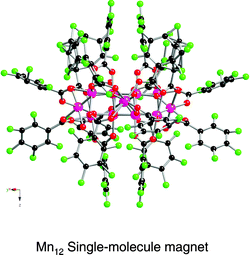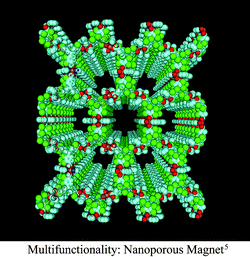Trends and challenges in molecule-based magnetic materials
Abstract
This issue of Journal of Materials Chemistry highlights recent progress in molecular magnetic materials. Eugenio Coronado and Dante Gatteschi introduce the issue and the importance of the field.
Molecular magnetism designates a relatively recent and emerging field of research that focuses on the use of molecular approaches to design, create and study new classes of magnetic materials in which the properties can be tuned at the molecular level. In the last two decades this field has rapidly evolved from the design of new molecule-based magnets possessing higher critical temperatures, toward the development of more complex magnetic materials with one or more functional properties of interest (bistable magnetic materials with switching properties, or multifunctional materials coupling magnetism with a second property), to the investigation of nanosized magnetic molecules and other nanostructures exhibiting quantum effects, and finally to materials processing aimed at applications.
The current trends in this research field can be bunched together around three main classes of molecular materials:
• multifunctional magnetic materials
• molecular nanomagnets
• nanostructured magnetic materials
Multifunctional materials is an important objective in the materials community, and molecule-based materials are attracting much attention in this regard as they are already known to exhibit most technologically important properties traditionally considered to be solely available for atom-based inorganic solids (e.g., magnetic ordering, electrical conductivity, superconductivity, ferroelectricity). But the ability to use conventional organic synthetic methodologies to modulate and combine properties of molecule-based materials justifies the optimism offered by the molecular approach for the development of new materials that is unparalleled in the world of atom-based solid-state chemistry. An extensive class of magnetic materials of this type are the so-called “switching magnetic materials”. These molecular materials exhibit bistability at the molecular level and therefore their magnetic properties can be tuned by the application of external stimuli (light, pressure, temperature, ...). Archetypes of switching magnetic materials are the so-called spin-crossover compounds1 and the magnets based on Prussian Blue analogues for which temperature-, light-, and pressure-switching have been demonstrated. Furthermore, on a truly molecular basis, cyanide bridged high-spin clusters have recently been identified as photo-physically interesting, and a photo-induced electron transfer has been shown to influence the magnetic properties of the metal complex.2 Finally, other classes of interesting opto-magnetic materials are the so-called chiral magnets in which the coupling between chirality and ferromagnetism may result in the observation of novel physical properties (magneto-chiral dichroism). Due to their switchable properties, the above materials are potentially useful for technological applications in molecular electronics, information storage or sensing.
Other classes of multifunctional materials are those exhibiting a coexistence of two properties (“dual-function materials”). These materials are hybrids generally formed by two molecular-based networks, where each network furnishes distinct physical properties. As the two networks are generally quasi-independent of each other from the electronic point of view, a coexistence of the two physical properties is anticipated in these materials. A remarkable example of this type is that of the magnetic molecular conductors.3 These materials are generally charge-transfer salts formed by a conducting network (usually formed by TTF-type organic donors) and by inorganic magnetic complexes acting as counterions. Some relevant results in this area have been the discovery of paramagnetic molecular metals and superconductors in the 1990s, and the discovery of ferromagnetic molecular metals in 2000. This type of crystalline material, which present layered nanostructures with alternating conducting and magnetic networks, has been the subject of thorough studies to understand the interplay of magnetism and (super)conductivity and the novel properties resulting from this combination such as, for example, the observation of field-induced superconductivity in one case. These results have set the possibility to achieve more technologically relevant goals, including potential applications in spintronics and nanoelectronics. The achievement of such goals will need the development of feasible processing techniques for convenient organization of the magnetic conductors as thin films or size-controlled nanostructures.
As far as the molecular nanomagnets are concerned, significant efforts are being devoted to obtain single-molecule magnets (SMMs) as they represent the ultimate step in the process of miniaturisation of magnetic molecular materials. Most of these molecular systems are polynuclear metal complexes formed by a magnetic cluster of exchange-coupled transition metal ions surrounded by shells of ligand molecules. These nano-scale magnetic materials exhibit slow relaxation of the magnetization at low temperatures with magnetic hysteresis analogous to that observed in bulk magnets, but with interesting quantum effects such as the quantum tunnelling of the magnetization.4 Owing to these properties applications of these molecules can be foreseen including high-density data storage and quantum computing. For that, much research is now being performed including the preparation of novel series of SMMs aiming at raising the energy barrier for magnetization reversal, and the organization and addressing of these SMMs on surfaces. Other applications of these nanomagnets that are being explored are in magnetic cooling (as magnetic refrigerants) due to the large magnetic entropy variations related to their large spin, and in biomedicine as magnetic contrast agents in magnetic resonance imaging and in hyperthermic treatment of tumours, just to mention two examples of interest. Another field which is developing very fast is that of single-chain magnets, one-dimensional homologues of SMMs, in principle capable of giving rise to higher blocking temperatures.
Nanostructured materials comprise either those materials having a nanometric size (nanoparticles, nanorods, ...), as well as those materials formed by structures of nanometric dimensions (thin films, monolayers, multilayers, nanoporous materials, ...). The molecular approach to the nanostructured molecular materials allows us to produce interesting examples of this kind. One example worth mentioning is that of the superparamagnetic nanoparticles in which the size is controlled by molecules used as capping ligands, templates or capsules. The peripheral molecules used in these cases can be useful for the processability of the nanoparticles and for incorporating some useful functionality to the nanoparticle (biocompatibility, for example), which can be of interest for its applications. On the other hand, these molecules can also be functionalized to favour self-assembling processes, thus generating supramolecular organizations of nanoparticles in 1, 2 and 3 dimensions. Current interest is also devoted to the generation of molecular nanostructures in 2 dimensions. Thus, as we have described before, the development of synthetic strategies to organize SMMs, or other magnetic molecules such as the switching spin-crossover complexes, on surfaces is one of the hottest topics in nanomagnetism both from the fundamental point of view (to explore the magnetic properties and the electron transport through a single molecule, and the role of the substrate in these properties), and from the point of view of applications (magnetic recording, quantum computing, ...). Other types of nanostructures are the magnetic multilayers which are of utmost importance in spintronics. However, these nanostructures have been scarcely explored in the field of molecular magnetism, as this field has been strongly focused on the preparation of crystalline materials. The situation is now starting to change and processing techniques, such as the Langmuir–Blodgett method or chemical vapor deposition, are expected to become more common in this field, in a way similar to what has happened in molecular opto-electronics (in the preparation of OLEDs, for example).
Clearly, the evolution of molecular magnetism from materials towards applications in molecular electronics, medicine and other related areas, together with the trend towards nanoscale materials/phenomena, expands the multidisciplinarity of the field. Indeed, the collaboration between chemists and physicists that was essential for the development of magnetochemistry in the 1970s is now expanding to incorporate other scientific communities working on surface and materials science and engineering, medicine, biochemistry and biophysics. In this frame, major advances in molecular magnetism will certainly occur via a stronger integration of these communities. Networks of Excellence such as “MAGMANet” which brings together European world-class groups with a long tradition in molecular magnetism and complementary expertises in chemistry, physics and materials science should play a major role.
The purpose of this themed issue is to highlight recent progress and perspectives in this multidisciplinary field. We hope that this issue will offer a valuable reference for the molecular magnetism community. This issue contains five feature articles which illustrate the current state-of-the-art and identify key challenges in future developments of the field: from the design and magneto-structural study of molecule-based magnets and switching multifunctional molecular materials, to the development of molecular electronic devices; from the design of molecular nanomagnets to the understanding of their magnetic and magnetothermal properties. The issue also contains many original contributions highlighting new achievements in the design, synthesis, magneto-structural characterization and modelling of new molecule-based magnets (i) and of new magnetic clusters and chains (ii), including the enhancement of the properties in molecular nanomagnets; the search for new multifunctional and hybrid materials (iii), including those exhibiting magnetic switching; and finally, the processing of all these types of materials as nanoparticles, nanocrystals and magnetic nanocomposites (iv).
We would like to thank all the authors of this themed issue for their efforts in presenting high-quality contributions. We wish also to thank all the staff members of the RSC for their kind assistance and dedication to this themed issue, in particular Graham McCann, Carol Stanier and Rebecca Gillan, and the entire Production team.
 | ||
| Plate1 Eugenio Coronado | ||
 | ||
| Plate2 Dante Gatteschi | ||
References
- J. A. Real, A. B. Gaspar and M. C. Munoz, Dalton Trans., 2005, 2062 RSC.
- J. M. Herrera, V. Marvaud, M. Verdaguer, J. Marrot, M. Kalisz and C. Mathoniere, Angew. Chem., Int. Ed., 2004, 43, 5468 CrossRef CAS.
- E. Coronado and P. Day, Chem. Rev., 2004, 104, 5419 CrossRef.
- D. Gatteschi and R. Sessoli, Angew. Chem., Int. Ed., 2003, 42, 268 CrossRef CAS.
- D. Maspoch, D. Ruiz-Molina, K. Wurst, N. Domingo, M. Cavallini, F. Biscarini, J. Tejada, C. Rovira and J. Veciana, Nat. Mater., 2003, 2, 190 CrossRef CAS.
| This journal is © The Royal Society of Chemistry 2006 |



